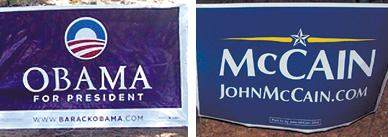Sen. Barack Obama swung through Albuquerque on Monday to talk health care, saying his policies would be similar to Gov. Richardson’s proposal for New Mexico. Sen. Hillary Clinton stopped in Española on Sunday to rally for Obama. Sen. John McCain was set to stump in Las Cruces on Wednesday.These visits aren’t the only sign that the national contenders are taking the state seriously. There are at least 23 others.That’s how many headquarters Sen. Barack Obama’s presidential campaign set up here. That number could reach 25 in the next couple of weeks, though those plans haven’t been solidified. For comparison, Democratic Sen. John Kerry dropped five offices into New Mexico when he ran for president in 2004. "We are not ceding any part of the state," says Adrian Saenz, the Obama Campaign’s New Mexico director. "We’re being as aggressive in Silver City, Las Vegas and Española as we are in Las Cruces, Albuquerque and Santa Fe."Campaign offices serve as a hub for volunteers and paid campaign staff. Most offices include phone banks where the candidate’s devotees try to drum up support. It’s also a place where those interested in volunteering can learn how to get out the vote.It looks like for the third-straight presidential election, New Mexico will be up for grabs. The latest polls show Obama ahead of Sen. John McCain by a few percentage points here. The Red Zone McCain is also zeroing in on the state. His campaign planted five offices, three of which were up and running a week before any of Obama’s offices, says Scott Darnell, acting director for the state’s Republican Party. "We beat Sen. Obama to the punch. We made thousands of calls statewide on behalf of Sen. McCain before Obama’s offices even opened."Darnell says he knows McCain can’t match Obama’s financial resources, but he’s counting on an already established network of Republican politicians and volunteers to turn New Mexico red in November. "We never suffered from the illusion we could outspend Obama," Darnell says. The state’s party faithful "will communicate Sen. McCain’s message just as effectively," he says.Close to half of Obama’s campaign offices are in the 2nd Congressional District, which is a more conservative part of New Mexico. Conchita Cruz, spokesperson for the state’s Democratic Party, says the Obama campaign is not afraid to go into parts of the state that usually vote Republican. "He’s taking Southern New Mexico seriously," Cruz says. "He’s making sure we get as many people from across the state registered to vote as possible." Native Votes Obama is also putting the first-ever presidential campaign office on a Native American reservation in Shiprock, N.M., part of the Navajo Nation. Saenz says it will give Obama an opportunity to court Native American voters in a way no other presidential nominee has. "Anybody who wants to run a successful campaign should be targeting the Native American vote," Saenz says. Darnell says McCain is also interested in winning over Native Americans. "Sen. McCain has a strong record of appealing to Native American voters," Darnell says. "That’s something Sen. Obama can’t claim."Cruz, Saenz and Darnell agree the state will play a key role in determining who will move into the White House in January. “The road to the presidency will run through New Mexico,” Cruz says. Getting Past the Hype Christie McAuley, director of curriculum development for the New Mexico Media Literacy Project, says the focus is a double-edged sword. While she’s excited the state is getting so much attention, McAuley says the numerous negative TV ads for both candidates could discourage people from voting. “All the attacks have the potential to wear people down and create apathy among voters,” she says. “When there’s apathy, fewer people go to the polls.”According to McAuley, some political theorists say this type campaign strategy is especially common when the race is close. “Persuading people not to vote for your opponent is often easier than persuading them to vote for you,” McAuley says.Cutting through the political rhetoric is a challenge, but McAuley says it’s the only way to find the truth. “If people really want to know the issues, they should take time to read, listen to, watch and sort through all of the information on the candidates,” McAuley says. “The best way to get facts is to steer clear of the 30-second sound bites and the attack ads that dominate the election landscape.”
To find out how to volunteer for the Obama or McCain campaigns, visit barackobama.com or johnmccain.com.Checkout factcheck.org and politifact.com for non-partisan takes on the candidates.





